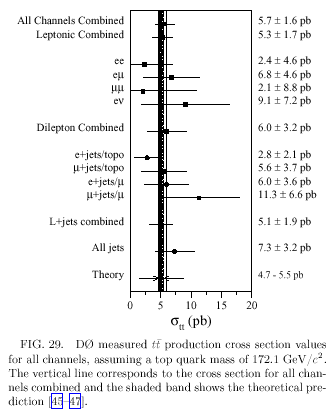 ...
...
Acording to hep-ex/0205019 by the Dzero Collaboration: "... Results are presented on a measurement of the
in ppbar collisions at sqrt{s} = 1.8 TeV from nine independent decay channels. The data were collected by the Dzero experiment during the 1992-1996 run of the Fermilab Tevatron Collider. A total of 80 candidate events are observed with an expected background of 38.8 +- 3.3 events. For a top quark mass of 172.1 GeV/c^2, the measured cross section is 5.69 +- 1.21 (stat) +- 1.04 (sys) pb. ...
... The first evidence for ttbar production was claimed by the CDF collaboration in April of 1994 ... At the time of the top quark discovery the following year, the CDF and D0 collaborations reported ttbar production cross sections of
sigma_ttbar = 6.8 + 3.6 - 2.4 pb for mt = 176 GeV/c^2 ... andsigma_ttbar = 6.4 +/- 2.2 pb for mt = 199 GeV/c^2 ... , respectively.
These results were updated by D0 (1997) and CDF (1998) to
sigma_ttbar = 5.5 +/- 1.8 pb for mt = 173.3 GeV/c^2 ... andsigma_ttbar = 7.6 + 1.8 - 1.5 pb for mt = 175 GeV/c^2 ... ,respectively.
In 2001, the CDF collaboration reported
sigma_ttbar = 6.5 + 1.7 - 1.4 pb for mt = 175 GeV/c^2 ...
as their final ttbar production cross section based on the 1992-1996 run of the Tevatron. The corresponding result from the D0 collaboration, reported in this article, is
sigma_ttbar = 5.7 +/- 1.6 pb for mt = 172.1 GeV/c^2 ...
 ...
...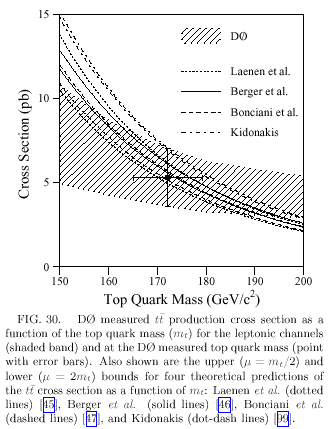 ...".
...".
In my opinion, the results shown in FIG. 30 are consistent with my preferred mass range for the T-quark, for the following reasons:
My opinion that my value of about 130 GeV/c^2 for tree-level T-quark mass is correct is supported (again, in my opinion) by the facts that the CDF ttbar cross section values tend to be higher than the D0 values, and a higher cross section indicates a lighter quark mass.
According to hep-ph/0112062 by Edmund L. Berger (Argonne): "... It has been known for a long time that the cross section for bottom[beauty]-quark b production at hadron collider energies exceeds theoretical expectations. ... The cross section for bottom-quark production at hadron collider energies exceeds the central value of predictions of next-to-leading order (NLO) perturbative quantum chro-modynamics (QCD) by about a factor of two ... This longstanding discrepancy has resisted fully satisfactory resolution within the standard model ... The NLO contributions are large, and it is not excluded that a combination of further higher-order effects in production and/or fragmentation may resolve the discrepancy. However, the disagreement is surprising because the relatively large mass of the bottom quark sets a hard scattering scale at which fixed-order perturbative QCD computations of other processes are generally successful. The photoproduction cross section at DESY's HERA ... and and the cross section in photon-photon reactions at CERN's LEP ... also exceed NLO expectations. ...
... An additional contribution from pair-production of light gluinos ~g, of mass 12 to 16 GeV, with two-body decays into bottom quarks and light bottom squarks ~b, helps to obtain a b production rate in better agreement with data. ...
... In the standard model, a global fit to all observables provides an indirect measurement of alpha_s at the scale of the Z boson mass MZ. The value alpha_s(MZ) = 0.1184 +/- 0.006 describes most observables properly ... Extrapolation from MZ to a lower scale mu with inclusion of a light gluino reduces alpha_s from its pure QCD value. ... A lesser value of alpha_s(mb) leads, under slower evolution, to the same alpha_s(MZ). ...".
In my opinion, the observation of higher production of Beauty Quarks than expected by conventional theoretical expectations may be due to use of the conventional value of about 170 GeV for the Truth Quark mass, rather than the value of about 130 GeV that is predicted by the D4-D5-E6-E7-E8 VoDou Physics model.
According to November 2001 slashdot postings about reports that "... The NuTeV collaboration ...[extraction of]... the electroweak parameter [the Weinberg angle] sin^2(theta_W) from measurement of the ratios of neutral current to charged current neutrino and anti-neutrino cross-sections ... is three standard deviations above the standard model prediction. ...":
"... by Zeinfeld on Friday November 09, @08:36PM (#2547033) (User #263942 Info | http://slashdot.org/) ... As a former experimentalist in the field (they [Oxford UK] gave me the Phd so I couldn't be all that bad) I am not getting excited. The problem is that the experiments are simply not accurate enough to jump up and down in celebration for such a miniscule deviation. What I am really suspicious about is that the number of observations is much lower than expected. That can happen because you just missed some particles you should have seen. You can have a deviation that is 'significant' at twenty or a hundred standard deviations and it can still be the result of experimental error rather than a flaw in the standard model. Given the way the physicists write their programs I would not be at all surprised if this turns out to be no more than the result of a flaw in PAW or GEANT.Then they will all share the same analysis programs even though they are known to be riddled with bugs. And don't start on about the Web, first off the Web code was not built on a twenty year old code base from the dawn of Fortran, second there were multiple versions of the code written from the very start. In 1992 there were 10 browsers and at least 5 Web servers. ...".
"... by Zeinfeld on Friday November 09, @10:47PM (#2547355) (User #263942 Info | http://slashdot.org/) ... If ... both Fermilab and CERN... used the same Monte-Carlo simulation or the same analysis package the potential for common failure is high. There was a similar event that happened with the 19KeV Neutrino, two apparently independent experiments turn out to have used the same counter unit with a bizare temperature-dependent fault that causes lost counts in wierd circumstances. ...".
"... by Zeinfeld on Friday November 09, @10:47PM (#2438163) (User #263942 Info | http://slashdot.org/) ... Last time I bothered to look I had 30 publications in the likes of Physics Review Letters. They mean absolutely nothing. If there is an experimental error the referee is not going to find it. ...".
"... by FredGray (fegray at npl dot uiuc dot edu) on Saturday November 10, @12:18AM (#2547557) (User #305594 Info | http://www.npl.uiuc.edu/~fegray) I don't know what analysis tools NuTeV used, but there is at least some competition to the mess called CERNLIB these days. Many "younger" collaborations have switched over to ROOT [root.cern.ch], which is mostly a clean break from the past. Nevertheless, its primary developers are Rene Brun and Fons Rademakers (familiar names from the old days), and at least one crucial bit of code (the MINUIT minimization engine) has been run through f2c and recycled, so it's not fully independent. Seriously, it would be very useful if someone were to rewrite MINUIT in an intelligible style. ...".
In February 2001, Andrzej Czarnecki and William J. Marciano wrote a paper entitled The Muon Anomalous Magnetic Moment: A Harbinger For "New Physics", hep-ph/0102122, in which they say:
"... QED, Hadronic, and Electroweak Standard Model contributions to the muon anomalous magnetic moment ... and their theoretical uncertainties are scrutinized. The status and implications of the recently reported 2.6 sigma experiment vs.theory deviation ... are discussed. Possible explanations due to supersymmetric loop effects ... , radiative mass mechanisms at the 1--2 TeV scale and other "New Physics" scenarios are examined. ...".
In November 2001, Marc Knecht and Andreas Nyffeler, in hep-ph/0111058, say:
"... The correction to the muon anomalous magnetic moment from the pion-pole contribution to the hadronic light-by-light scattering is considered ... The value obtained ... disagrees with other recent calculations. ... This result substantially reduces the difference between the experimental value of ...[ the muon anomalous magnetic moment ]... and its theoretical counterpart in the standard model. ...".
In December 2001, Masashi Hayakawa and Toichiro Kinoshita, in hep-ph/0112102, say:
"... We correct the error in the sign of the pseudoscalar pole contribution to the muon g-2 ... The error originates from our oversight of a feature of the algebraic manipulation program FORM which defines the epsilon-tensor ... To circumvent this problem, we replaced the product epsilon ... and obtained a positive value for the pseudoscalar pole contribution, in agreement with the recent result obtained by Knecht et al ...".
In December 2001, Johan Bijnens, Elisabetta Pallante, and Joaquim Prades, in hep-ph/0112255, say:
"... We comment on the recent calculations of the pion pole part of the light-by-light contribution to the muon anomalous magnetic moment and we point out where the analysis in our previous work was mistaken. ...".
According to an article by Adrian Cho in Science 294 (21 December 2001) 2449-2451:
"... In February [2001], researchers at Brookhaven National Laboratory ... reported that ... the muon was 4 billionths more magnetic than predicted by the Standard Model of Particle Physics ... Many physicists interpreted the result as possible evidence of supersymmetry ... But the true cause of the discrepancy is far less exciting. Misled by an extra minus sign, theoretical physicists underestimated the predicted value of the muon's magnetism. ... In 1995 two groups independently calculated the contribution for ... hadronic light-by-light scattering ... but both got the sign of the answer wrong. If the negative results are made positive, the theoretical prediction for the muon's mangnetism goes up enough to shrink the discrepancy by nearly half. That leaves the difference only slightly bigger than the theoretical and experimental uncertainties, spoiling the case for new particles. ...".
According to hep-ph/0208106 by Feng, Matchev, and Shadmi:
"... The Measurement of the Muon's Anomalous Magnetic Moment Isn't ...... what has been measured is the muon's anomalous spin precession frequency. ... this receives contributions from both the muon's anomalous magnetic and electric dipole moments, and the reported data and all existing constraints cannot distinguish between the two. ...".
According to hep-ex/0001014, Recent Results from the L3 Experiment, by Salvatore Mele of CERN [some comments by me set off by brackets]: "... A data sample corresponding to an integrated luminosity of 232 pb^(-1) was collected in 1997 and 1998 by the L3 experiment at LEP in e+ e- collisions at centre-of-mass energies between 181.7 GeV and 188.7 GeV. ... the cross sections for single W production ... [are compared in this figure] ...
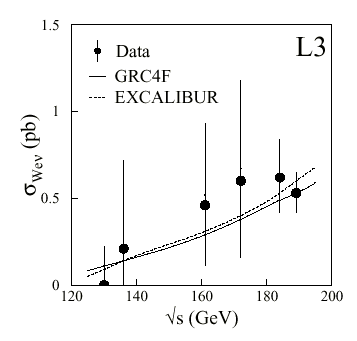
... to the SM predictions obtained with the EXCALIBUR and GRC4F MC [Monte Carlo] programs. ...
[The data in the region 160 GeV to 180 GeV seem to be substantially higher than the Monte Carlo predictions, indicating to me that the background in that region is incompletely understood.][In this figure,
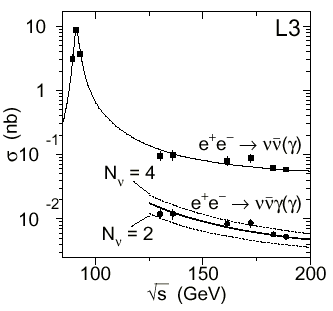
the data in the 175 GeV region is consistent with 4 generations of neutrinos, rather than 3, also indicating to me that processes in that region are incompletely understood.]
... [the following figure] presents the evolution of the WW cross section with sqrt(s) as measured by L3,
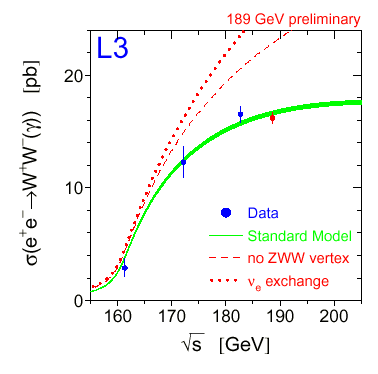
compared with the theory predictions. ...
[Again, the data in the region around 180 GeV seem to be substantially higher than the Standard Model predictions, indicating to me that the background in that region is incompletely understood.] ...".
[note added 25 Feb 2002: Late last night (Sunday 24 Feb 2002) I first viewed an e-mail message sent to me by Salvatore Mele, a copy of which message is quoted here in full:
" Delivered-To: tsmith@innerx.net X-Authentication-Warning: pcl3ep02.cern.ch: smele owned process doing -bs Date: Sat, 23 Feb 2002 16:43:41 +0100 (CET) From: Salvatore Mele <Salvatore.Mele@cern.ch> X-Sender: smele@pcl3ep02.cern.ch To: tsmith@innerx.net Subject: Your interpretation of hep-ex/0001014 MIME-Version: 1.0 Dear Mr. Smith, you authored both the following paper and the following web page: http://arXiv.org/abs/physics/0006041 http://www.innerx.net/personal/tsmith/TCZchron.html#Jan00-1 I appreciate your reference to the results I summarise in hep-ex/0001014. I have to draw your attention to the fact that in experimental physics we do quote an uncertainty associated to measurments. In the three plots you've extracted from my publication, this is represented by the vertical bars, called error bars. These concepts are described in introductory textbooks on statistics. Physics results have to be interpreted within these uncertainties, conventionally associated to a probability of 68% that the true value of the measured quantity lies in that range. In this spirit, the first and last of my plots are in excellent agreement with the predictions and your statement "substantially higher" is void of any statistical meaning and simply wrong. As for the neutrino plot, in experimental physics you claim a deviation from a model when your data are three lenghts of those error bars away from your prediction that means more than 99% probability of an inconsistency. This is cleary not the case. In addition, to claim discoveries or lose faith into a model, five of those error bar lengths are needed, corresponding to probabilities of the order of 10^-5 Regards, Salvatore Mele Research Staff CERN - European Organisation for Nuclear Research "
My comments on Salvatore Mele's message quoted above are:
According to hep-ex/9910012 by the H1 and ZEUS Collaborations at HERA: "...Between mid-1994 and the end of 1997 the electron-proton collider HERA at DESY has been operated ... . In this period, ZEUS and H1 have collected e + p data samples corresponding to integrated luminosities of 47.7 pb^(-1) and 37 pb^(-1), respectively. In 1998 and the first half of 1999, each experiment has taken about 15 pb^(-1) of ... data ... The excess in the H1 data is still present at Me = 200 GeV but has not been corroborated by the 1997 data. Also ZEUS observes an excess at Mej > 200 GeV; however, the decay angular distribution does not support a LQ interpretation ...
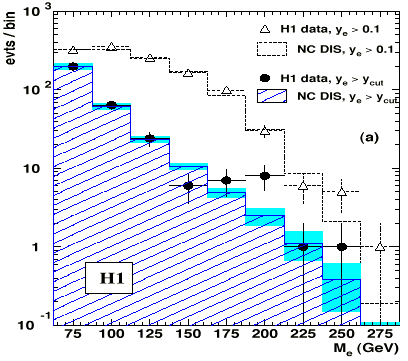
... The symbols with statistical error bars represent the data, the histograms the DIS MC. The H1 data are shown before (open triangles) and after (full dots, hatched histogram) a cut y>ymin(Me). The shaded area indicates the uncertainty of the SM prediction. ...".
In hep-ex/9909042, CDF studied the fraction F0 of W bosons in Truth Quark decays with zero helicity in the Truth Quark rest frame, with the results shown in their Table 1:
"... Result of measurements for F0 and description of sample content. The fifth column lists the measurement after a correction for an acceptance bias is applied. Each dilepton event enters twice in the last row.
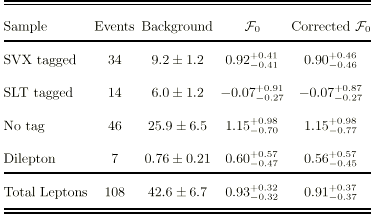 ...".
...".
CDF says: "... The weak decays of the top quark should be described by the universal V - A charged-current interactions of the standard model. The theory makes a specific prediction for the polarization state of the W bosons, which can be measured using the lepton momentum spectrum in the decay chain t !-> bW with W -> l b. Because the top ... is heavier than the W, the W polarization in top decay is fundamentally different from that of other weak decays. Observation of the predicted lepton momentum spectrum can verify that this is the top quark of the standard model. In top decays with a pure V - A coupling the amplitude for positive helicity W+ bosons is suppressed by the chiral factors of order mb^2 / MW^2, and the W helicity is a superposition of just the zero and negative helicity states. At tree level in the standard model, the relative fraction F0 of the longitudinal (or zero helicity) W's in the top rest frame is predicted to be:
... This expression is valid when mt is signi\ficantly greater than MW. The dominance of the zero helicity state may be understood in terms of the large top Yukawa coupling to the longitudinal mode of the W. ...".
If, as predicted by the D4-D-E6-E7 physics model, mt = 130 GeV, then F0 is about 60%, or about 0.6.
The W helicity results for Dilepton events described by CDF are consistent with the F0 = 0.6 fraction predicted by the D4-D-E6-E7 physics model.
In my opinion the set of Dilepton events is more representative of Truth Quark decay events than the sets of Semilepton events, because
The W helicity results for Semilepton SLT Tagged (but not also SVX Tagged or Dilepton) events described by CDF, which have low transverse momentum, have F0 about 0 and are consistent with no longitudinal polarization. In my opinion, most of the Semilepton SLT Tagged events do not represent Truth Quark decay. What sort of process could they be? According to Collider Physics (updated edition), by Barger and Phillips (Addison-Wesley 1997), at pages 267 and 437: the Standard Model and V - A interaction predicts "... maximal helicity at production and decay vertices. ..." and "... the [quark-antiquark to W+W-] ... continuuum background is dominantly [transversely polarized W-bosons] ...".
The W helicity results for Semilepton SVX Tagged and No Tag events described by CDF, have F0 about 0.9 and 1.1, respectively, and are consistent with predominantly longitudinal polarization. In my opinion, most of the Semilepton SVX Tagged and No Tag events do not represent Truth Quark decay.
What sort of process is consistent with F0 about unity ?
In hep-ph/9904408, Standard Model Confronting New Results for e'/e, Bosch, Buras, Gorbahn, Jaeger, Jamin, Lautenbacher, and Silvestrini say (in part, with bold-face added by me to emphasize points that I think are very important - further, I put their history in list form - detailed references are in their paper):
"... There is a long history of calculations of e'/e in the Standard Model.
had of course also an important impact on e'/e. ...
... We analyze the CP violating ratio e'/e in the Standard Model in view of the new KTeV results. We review the present status of the most important non-perturbative parameters B_6^(1/2), B_8^(3/2), and Bbar_K and of the strange quark mass ms. ... Updating the values of the CKM parameters, of mt and LAMBDA_MSbar(4) and using Gaussian errors for the experimental input and at distributions for the theoretical parameters we find e'/e substantially below the NA31 and KTeV data:
e'/e = 5.2 +4.6 -2.7 x 10^(-4)
in the NDR and HV renormalization schemes respectively. ...
...The grand average including NA31, E731 and KTeV results reads
very close to the NA31 result but with a smaller error. The error should be further reduced once the first data from NA48 collaboration at CERN are available and complete data from both collaborations have been analyzed. It is also of great interest to see what value for e'/e will be measured by KLOE at Frascati, which uses a different experimental technique than KTeV and NA48. ...
... Analyzing the dependence on various parameters we find that only for extreme values of B_6^(1/2), B_8^(3/2) and ms as well as suitable values of CKM parameters and LAMBDA_MSbar(4), the ratio e'/e can be made consistent with data. ...
... [we assume that] ... mt(mt) = 165 GeV ...
... It should also be emphasized that the large top quark mass plays an important role in obtaining the experimental value for e. Had mt been substantially lower than it is, the theoretical value of e would be below the experimental one. ...
... As we stressed at the beginning of this paper the main new parameter to befitted bymeans of e'/e is ImLambda_t. Our analysis indicates that the Standard Model estimates of e'/e are generally below the data. If the parameters ms, B_6^(1/2), B_8^(3/2), LAMBDA_MSbar(4), and OMEGA_(eta+eta') are such that ImLambda_t consistent with e ... cannot accomodate the experimental value of e'/e, one has to conclude that new contributions from new physics are required. ... Unfortunately, the strong dependence of the lower bound on the parameters involved precludes any firm conclusions. Similar comments apply to the possible impact of e'/e on the analysis of the unitarity triangle ...
...We have seen that the Standard Model estimates of e'/e are generally below the experimental results from NA31 and KTeV. In view of the large theoretical uncertainties it is, however, impossible at present to conclude that new physics is signaled by the e'/e data. ...".
January 2001 update: According to hep-ex/0101034, by T. Gershon "... The NA48 experiment at CERN has performed a measurement of direct CP violation in the neutral kaon system, based on data collected in 1997 and 1998. The preliminary result for the parameter Re(e'/e) is (14.0 +/- 4.3) x 10^(-4). ... The result presented in this paper confirms the existence of the direct CP violation. ... Taking into account the three most precise published results ... and the combined NA48 result the world average is Re(e'/e) is (19.3 +/- 2.4) x 10^(-4). ... However the CHI^2 = 10.5/3 indicates poor consistency among the values. ...". Although the NA48 value around Re(e'/e) = 14 x 10^(-4) is lower than the 1999 values of around Re(e'/e) = 21 x 10(-4), the NA48 value is still substantially higher than the theoretical values of around Re(e'/e) = 5.5-7.7 x 10(-4), so my opinion stated above is still my opinion.
July 2003 update: According to hep-ph/0306217. by Andrzej J. Buras and Matthias Jamin "... During the last four years several parameters relevant for the analysis of the CP-violating ratio e' / e improved and/or changed significantly. In particular, the experimental value of e' / e and the strange quark mass decreased, the uncertainty in the CKM factor has been reduced, and for a value of the hadronic matrix element of the dominant electroweak penguin operator Q8, some consensus has been reached among several theory groups. ... After tremendous efforts, on the experimental side the world average based on the recent results from NA48 ... and KTeV ... and previous results from NA31 ... and E731 ... reads e' / e = (16.6 ± 1.6) x 10^(-4).
hep-ex/9810029 is a revised analysis by CDF of 8 Dilepton events in which CDF says "We present a new measurement of the top quark mass in t -tbar events in which both W bosons from top quarks decay into leptons ... We measure a top quark mass of 167.4 +/- 10.3(stat) +/- 4.8(syst) GeV/c^2 from a sample of eight events. ... This measurement supersedes our previously reported result in the dilepton channel ..."
The 8 events of the revised CDF analysis are shown in Figure 2 of hep-ex/9810029 as
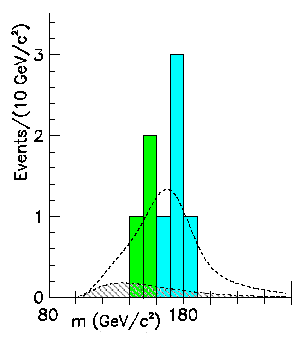
When compared to the total of 11 candidate events of CDF's previously reported results in the dilepton channel
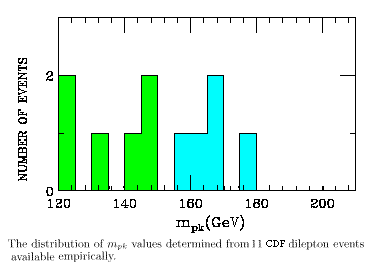
it appears to me that CDF has kept the 8 highest-mass dilepton events, and thrown away the 3 lowest-mass dilepton events that were indicated to be in the 120-135 GeV range.
If the 3 lowest-mass events are included, the histogram seems to me to be consistent with the events shown in green representing Truth Quark mass of about 130 GeV, with the events shown in blue not representing the Truth Quark (compare Fermilab histograms of Semileptonic events).
It also appears to me that the CDF revision has shifted the mass scale upward by about 10 GeV, since the highest energy event is shown to be in a bin whose high side is 190 GeV in the revised CDF analysis, but 180 GeV in the previous CDF analysis.
In that connection, the revised CDF analysis states "... The mass reconstruction procedure used here is quite different from that used for the lepton plus jets sample ... We cross-check the present procedure by applying it to the five events of the lepton plus four jets mass sample in which two jets are tagged as b- jets by the SVX. We assume that the two untagged jets are the products of the hadronic W decay and mimic the dilepton decay by treating the highest ET untagged jet as a lepton and the second untagged jet as a neutrino. The present likelihood method then gives a top quark mass from the five events of 181.5 +/- 12.6 GeV/c^2, which differs by 11 GeV/c^2 from that obtained with the lepton plus jets kinematic fit procedures, 170.1 +/- 9.3 GeV/c^2. ..."
Further, such an overstatement of the mass is consistent with my analysis of D0 Dilepton events.
hep-ex/9809011 is a review article expounding Fermilab's view that Mt = 173.8 +/- 5.0 GeV, as opposed to my view of about 130 GeV. It substantially summarizes the data and analyses of earlier papers. The data and analyses are discussed in more detail in the rest of this web page, and the pages to which it is linked.
Melnikov and Yelkhovsky, in hep-ph/9802379, have calculated the next-to-next-to-leading order correction to the cross section for Truth Quark pair production in e+ e- annihilation in the threshold region and found that the magnitude of the NNLO correction is comparable to the size of the NLO corrections. They also note that a paper by Hoang and Teubner, in hep-ph/9801397, agrees with their qualitative conclusions about the size of the NNLO corrections.
M. Jezabek, J.H. Kuhn, M. Peter, Y. Sumino, and T. Teubner, in hep-ph/9802373, have calculated the "... the full second-order corrections to the static QCD potential in the analysis of the ttbar threshold cross section...." and found that "... There is an unexpectedly large difference between the QCD potential improved by the renormalization-group equation in momentum space and the potential improved by the renormalization-group equation in coordinate space. This difference remains even at a fairly short distance 1/r \simeq 100 GeV and its origin can be understood within perturbative QCD. We scrutinize the theoretical uncertainties of the QCD potential in relation to the ttbar threshold cross section. In particular there exists a theoretical uncertainty which limits our present theoretical accuracy of the ttbar threshold cross section at the peak to be not better than 6% within perturbative QCD. ... Some indications can be obtained by looking into the nature of the perturbative expansion of each potential. Within our present knowledge of the static QCD potential, the perturbative series looks more convergent for the momentum-space potential than for the coordinate-space potential. ..." They give, for the first 3 terms in the perturbative expansion:
for momentum-space: - 0.6101 a^2 - 0.2449 a^3 - 1.198 a^4 + ...
and
for coordinate-space: - 0.6101 a^2 - 0.2449 a^3 - 1.945 a^4 + ...
Further details are in the paper, which is about 16 pages long.

The histogram above is adapted from figure 6 of Dalitz and Goldstein, hep-ph/9802249, dated 4 Feb 98, who state "... we illustrate our method by examining 3 dilepton events which have been reported in the literature (Abe etal. 1994b), commenting further on the additional 11 events which have become available since the 1997 Electron-Photon conference at Hamburg in July [Giromini, P., Top physics. In Proc. 18th Intl. Conf. on Lepton-Photon Interactions, Hamburg, Germany, 28 July 1997, to be published.] ... We have carried out [Monte Carlo] calculations ... for 100,000 dilepton events with m0 = 140 GeV. The ... number of events plotted is 1899, and the mass distribution P (mpk) appears much sharper than for m0 = 170 GeV. For both m0 = 140 and 170 GeV, the peak obtained for P (mpk) is in the bin (m0;m0 + 2) but its distribution lies mostly below m0, being markedly asymmetric. The mean mass < mpk > is 136.1 GeV and the median is 138.0 GeV. ..."
The paper of Dalitz and Goldstein also discusses D0 Dilepton events, as well as some Unilepton events.
The abstract of the CDF paper (hep-ex/9802017, dated 18 Feb 98) states: "We present an analysis of dilepton events originating from ttbar production in pbarp collisions at sqrt(s) =1:8 TeV at the Fermilab Tevatron Collider. The sample corresponds to an integrated luminosity of 109 +/- 7 pb^(-1). We observe 9 candidate events, with an estimated background of 2.4 +/- 0:5 events.We determine the mass of the top quark to be Mtop = 161 +/- 17 (stat:) +/- 10 (syst:) GeV/c^2 . In addition we measure a ttbar production cross section of 8.2 + 4.4 - 3.4 pb (where Mtop = 175 GeV/c^2 has been assumed for the acceptance estimate)."
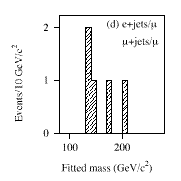
When event selection cuts were applied by D0 to the approximately 125 pb-1 of data from the 1992-1996 collider runs, 91 events were selected, 7 of which had a tag muon. After an additional cut based on Chi-squared less than 10, the 7 tagged events were reduced to the 5 shown on the histogram above (taken from Figure 25 of hep-ex/9801025). All 5 of those tagged events also passed the Low Bias selection cut applied by D0.
One event which would have otherwise passed the cuts, event (95653; 10822), was removed by D0 from its analysis because it was selected by the dilepton mass analysis. That event contained two electron candidates. However, one of the electrons just grazed the edge of the outer drift chamber, passing through the inner layers but not the outer ones. Thus, although there are hits in the inner layers, a complete track was not reconstructed. This event also contains a muon near one of its jets, consistent with b quark decay. If this event is treated as a l +jets candidate, it has a fit Chi-squared of 0.92 and fitted Truth Quark mass of 138.7 GeV (see footnote 10 of hep-ex/9801025).
Fig. 24 of hep-ex/9801025 shows histograms for the 91 candidate events, with the subset that passed the Low Bias cut shown as shaded:
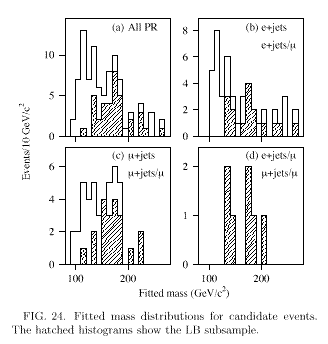
Fig. 25 of hep-ex/9801025 shows histograms for the 77 events that survived the Chi-squared less than 10 cut, with the subset that passed the Low Bias cut shown as shaded:

Fig. 27 of hep-ex/9801025 shows one histogram for all of the 77 events that survived the Chi-squared less than 10 cut. Note the peaks in the 110-140 GeV bins.
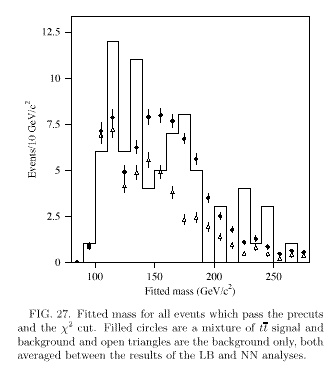
Fig. 28(c) of hep-ex/9801025 shows one histogram for the 31 events that survived the Chi-squared less than 10 cut and also survived the Low Bias selection cut. Note the peak in the 130-140 GeV bin.
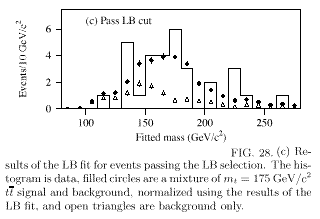
The abstract of hep-ex/9801025 does not explicitly mention the 5 tagged events that passed the Chi-squared less than 10 cut, nor does the abstract explicitly mention the 138.7 GeV event that was removed from the set of candidate events by D0. The abstract states: "We determine the top quark mass mt using t-tbar pairs produced in the D0 detector by sqrt(s) = 1:8 TeV p-pbar collisions in a 125 pb-1 exposure at the Fermilab Tevatron. We make a two constraint fit to mt in t-tbar to bW+ + bbarW- final states with one W boson decaying to q-qbar and the other to e + neutrino or mu + neutrino. Likelihood fits to the data yield mt(l + jets) = 173.3 +/- 5.6 (stat) +/- 5.5 (syst) GeV/c2. When this result is combined with an analysis of events in which both W bosons decay into leptons, we obtain mt = 172.1 +/- 5.2 (stat) +/- 4:9 (syst) GeV/c2. An alternate analysis, using three constraint fits to fixed top quark masses, gives mt(l + jets) = 176.0 +/- 7:9 (stat) +/- 4.8 (syst) GeV/c2, consistent with the above result. Studies of kinematic distributions of the top quark candidates are also presented."
The abstract, which does not explicitly mention the SLT events (in which jets formed by the fragmentation of b quarks are identifed, or tagged, by finding additional leptons from semileptonic b decays), states:
"We present a measurement of the top quark mass using a sample of t-tbar decays into an electron or a muon, a neutrino, and four jets. The data were collected in p-pbar collisions at sqrt(s) = 1.8 TeV with the Collider Detector at Fermilab and correspond to an integrated luminosity of 109 pb^(- 1) . We measure the top quark mass to be 175.9 +/- 4.8(stat.) +/- 4.9(syst.) GeV/c^2 ."
The mass value stated in the abstract was primarily based on events that were either SVX tagged (by reconstructing secondary vertices from b hadron decays with the silicon vertex detector), SVX double tagged, or untagged. The 14 SLT tagged events that gave a Truth Quark Mass of 142 GeV (+33, -14) had no SVX tag.
Events (10 GeV/c^2)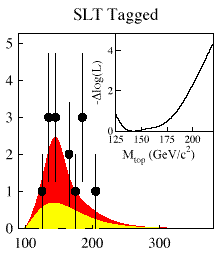
D0 at Fermilab in hep-ex/9703008, did likelihood fits to 125 pb^(-1) of data from 1992-1996 p-pbar collisions at 1.8 TeV, giving a the Truth Quark mass of 173.3 GeV (+/- 5.6 stat +/- 6.2 syst).
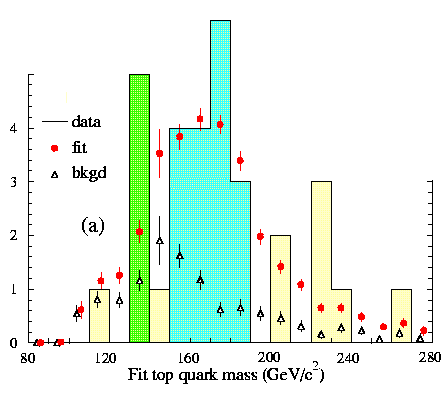
The green bar represents a bin in the 130-140 GeV range containing Semileptonic events deemed insignificant by D0, but considered by me to represent the T-quark,
HERA H1 collaboration at DESY announced ep scattering results at Q^2 greater than 15,000 GeV^2 showing an excess of events over the expectation of the standard DIS model of 12 NC events observed versus about 5 expected and 4 CC events observed versus about 2 expected. 6 of the 7 excess NC events are in a mass window of 200 Gev +/- 25 GeV, for which 7 events were observed and about 1 expected. The HERA H1 mass window of 200 GeV +/- 25 GeV overlaps substantially with the semileptonic Truth quark mass range of 170 GeV to 199 GeV. HERA ZEUS, also at DESY, has observed events at Q^2 greater than 35,000 GeV^2. ZEUS observed 2 events versus about 0.145 expected and at x greater than 0.55 and y greater than 0.25 observed 4 events versus about 0.91 expected, while observations below Q^2 = 15,000 GeV^2 were consistent with expectations. The HERA ZEUS results indicate that the standard DIS model is not consistent with experimental observations in the energy range above around 180 GeV, but is consistent below around 120 GeV. As HERA H1 says: "... It should be noted that inelastic single Z0 and W+- production is not contained in the standard DIS model ... and thus it is treated here as a background source. Especially contibutions from radiation of a Z0 or W+- from a quark can give rise to forward positrons and thus mimic NC DIS events at very high Q^2." Further, the analysis of Bassler and Bernardi of the HERA events concludes that the HERA data "... render unlikely an interpretation of the excess observed by [H1 and ZEUS] as originating from the decay of a single narrow resonance." The HERA data and analysis are discussed further HERE.
S. Dittmaier and D. Schildknecht discuss the implications of 1996 electroweak data on the Higgs and T-quark masses. Although their best fit to all data was (not including Fermilab direct data on T-quark mass) approximately Mt = 155 GeV and MH = 40 GeV I note that within 1-sigma their analysis of two parameters, epsilon (the neutral vector boson mixing parameter) and delta-yb (the Beauty quark coupling parameter), is consistent with the D4-D5-E6 values of Mt = 130 GeV and MH = 146 GeV, if the LEP value of the Weinberg angle s2w = 0.23200 is used.
If the LEP value of the Weinberg angle s2w = 0.23200 is used, and the SLD value s2w = 0.23165 is excluded (compare the D4-D5-E6 theory tree-level value s2w = 0.2334), then, approximately, Mt = 155 GeV and MH = 100 GeV:
If the LEP value of s2w = 0.23200 is used, then the 1-sigma ellipsoid in the plane of epsilon and delta-yb includes the D4-D5-E6 values of Mt = 130 GeV and MH = 146 GeV:
Here epsilon is the neutral vector boson mixing parameter and delta-yb is the Beauty quark coupling parameter. The other effective parameters in the overall fit are delta-x, the vector boson mass parameter, and delta-y, the charged lepton coupling parameter. If the LEP value of s2w = 0.23200 is used, then only the delta-x parameter excludes the D4-D5-E6 values of Mt and MH at the 1-sigma level:
Dittmaier and Schildknecht compared two theoretical predictions, viz. the one including all one-loop contributions (boson+fermion loops) and the one consisting of fermion loops only. They found that: "In the case of the mass parameter delta x and the mixing parameter epsilon, the pure contributions of the fermion loops to the W+, W-, Z and photon boson propagators, i.e., neglecting all contributions involving loops containing vector bosons, delta x = delta x (fermionic) epsilon = epsilon (fermionic) lead to consistency with experimental data. " My sincere thanks (23 Oct 96) to Stefan Dittmaier for pointing out to me errors in earlier versions of this page discussing the Dittmaier-Schildknecht paper. I would also like to make clear that any interpretation of their paper on this WWW page is strictly my own personal opinion, and in no way indicates whether or not they agree or disagree with any of my interpretations.
Orr, Stelzer, and Stirling "...have computed ...[the third-order QCD].. tree-level cross section for t-tbar production and decay with an extra jet at the Tevatron and the LHC. ... At the Tevatron we find that the contribution from gluons radiated in the [t quark] production process is comparable to that from decay. ... The distribution angle between the extra jet and the b quark is dominated at small angles by the decay-stage contribution, but the production-stage piece is non-negligible in that region as well. The bottom line is that there is no clear way experimentally to distinguish the two contributions, and they must be taken into account together in our analyses." They also note that HERWIG version 5.8 contained "...a bug which caused decay-stage radiation to be suppressed." and that in HERWIG version 5.9 "...there now appears to be too much decay-stage radiation...", and that HERWIG also has a discrepancy in the production-stage radiation which appears on the jet rapidity distribution: "The HERWIG distribution shows a slight dip in the central region; the matrix element distribution does not."
Patrascioiu and Seiler propose to resolve the QCD ALPHA_s discrepancy that had been noted by Shifman between high energy observation, giving ALPHA_s = 0.123, and low energy observations that extend by the renormalization group to ALPHA_s = 0.113 and are closer to the D4-D5-E6 model value that extends by the renormalization group to ALPHA_s = 0.106 by using nonperturbative lattice LQCD instead of perturbative PQCD. They contend that PQCD and asymptotic freedom are NOT true properties of physical QCD, and that LQCD suggests a nonzero fixed point for ALPHA_s.
They point out that the slower running of ALPHA_s under LQCD "...may also be expressed by saying that Lambda_QCD is not constant but an increasing function of the momentum Q." If they are correct, the renormalization group equation I used to calculate ALPHA_s is not valid, so that ALPHA_s = 0.106 is not the true value for 91 GeV under the D4-D5-E6 model. The true 91 GeV value for the D4-D5-E6 model ALPHA_s should be higher, closer to the high-energy experimental ALPHA_s = 0.123. Leader and Stamenov have proposed that a QCD fixed point (such as proposed by Patrascioiu and Seiler) may explain the observation of CDF at Fermilab, in hep-ex/9601008, that 19.5 pb^(-1) of data indicate that "The cross section for jets with ET greater than 200 GeV is significantly higher than current predictions based on third-order alpha_s perturbative QCD calculations." so that Perturbative QCD may not be physically accurate.
C. Campagnari and M. Franklin review the search for the Truth Quark at CDF and D0 (to be published in Rev. Mod. Phys.). At pages 131 and 132, they give these results (here the /c^2 is suppressed from GeV/c^2) for mass determined by reconstruction techniques, as well as for indirect (and probably less reliable) mass determination by analysis of kinematic quantities: For Semi-Leptonic Lepton + Jets events: CDF kinematic result: Mt = 180 +/- 12(stat) (+19/-15)(syst) GeV; CDF mass reconstruction result: Mt = 176 +/- 9 GeV; D0 mass reconstruction result: Mt = 170 +/- 18 GeV. For Dilepton events: CDF kinematic result: Mt = 159 (+24/-22)(stat) +/- 17(syst) GeV; D0 mass reconstruction result: Mt = 145 +/- 25(stat) +/- 20(syst) GeV.
A. P. Heinson discusses about 50 pb^(-1) of data from 1992 to 1995: For Semi-Leptonic Lepton + Jets events: Mt = 199 +24 -30 GeV; For Dilepton events: Mt = 145 +/- 32 GeV.
Dalitz and Goldstein, in hep-ph/9506232, analyze the recent seven L(+/-)4jet events and, in accord with CDF, get a mass estimate of about 175 GeV for those events. They also note that it is far from sure that all of the L(+/-)4jet events are due to t-tbar production and decay. Their analysis of e(+/-)mu(+/-)2jet events gives a somewhat lower peak t-quark mass (about 156 GeV). When they consider the CDF event 45047/104393 to be a dilepton event with both leptons hard, and combining two jets into a single jet, they get a good fit as a t-tbar event with t-quark mass 136 (+18 -14) GeV. Goldstein, in hep-ph/9611314, has since taken into account spin correlation of t-tbar pairs at Tevatron energies, finding that: the Monte Carlo mass distribution is more sharply peaked; and the peaks of his previous analysis of dileptonic events are shifted slightly (perhaps 6 GeV or so) upward, but the previous conclusion that dilepton events indicate a lower mass for the Truth quark than semileptonic events remains a valid conclusion.
Fermilab released a CDF paper and a D0 paper, each analyzing about 50 pb-1 of data, mostly Semileptonic events. The CDF paper assigns background and makes fits, and gets a T-quark mass of about 176 GeV and a production cross section of about 6.8 pb. The D0 paper assigns background and makes fits, and gets a T-quark mass of about 199 GeV and a production cross section of about 6.4 pb.
On 29 Sep 94 the D0 experiment reported in hep-ex/9409006 observation of 7 T-Tbar candidate events in 13.5 pb^-1 from the 1992-93 run, and concluded that the statistics are so limited that there is no clear evidence for discovery of the T-quark. Of the 7 events, 1 is a dilepton e-mu event. It is analyzed by D0 in Phys. Rev. Lett. 72 (1994) 2138 as being in a relatively low background region and as having a likelihood distribution that is maximized for a Truth Quark mass of about 145 GeV/c^2.
On 26 April 1994, CDF released FERMILAB-PUB-94/097-E analyzing
19.3 pb-1 integrated luminosity between August 1992 and May 1993.
CDF found 2 dilepton events (41540 127085 and 47122 38382),
(CDF 1988 and CDF 1989 were from earlier runs and
not studied in the paper)
background 0.56(+0.25/-0.13).
CDF also found 6 events with jets and
B-quark identified by a secondary vertex,
background 2.3 (+/-0.3),
and 7 events with jets and
B-quark identified by semileptonic decay,
background 3.1 (+/-0.3).
The 6 secondary vertex and 7 semileptonic decay events
had 3 events in common.
The probability that the yield is background
is estimated by CDF as 0.26%.
Assuming the excess over background is due to T-antiT,
CDF reports that a constrained fitting on a subset
of the events gives 174 (+/-10)(+13/-12) GeV,
with T-antiT cross section 13.9 (+6.1/-4.8) pb.
HERE ARE MY COMMENTS on FERMILAB-PUB-94/097-E:
1.
The 7-event histogram for W+multijets, with b-tags,
is Figure 63, which
(in ASCII, with no. of events above T-mass in GeV)
looks like:
1 1 2 2 1
80 90 100 110 120 130 140 150 160 170 180 190 200 210 220 230 24
From this, CDF gets mT = 174 GeV and
sigma = 10 GeV/c^2 for the
b-tag W+multijet events.
As you can see, there is 1 event in the 130-140 GeV bin that
is consistent with the D4-D5-E6 model value of 130 GeV.
As to the other 6 events, I wonder
(I do NOT yet know, because I have not yet done calculations)
whether they could be background
from WW (160 GeV), WZ (170 GeV), and/or ZZ(180 GeV).
(Here I used mW = 80 GeV and mZ = 90 GeV, which are rough figures.)
2.
There is a 26-event histogram for W+(3 or more)jets, WITHOUT b-tags,
that is Figure 65, and which
(in ASCII, with no. of events above T-mass in GeV)
looks like:
1 1 1 8 2 3 4 4 2
80 90 100 110 120 130 140 150 160 170 180 190 200 210 220 230 240
CDF then says (on p. 140):
"...There are 13 events with a mass above 160 GeV/c^2,
whereas the bin with masses
between 140 and 150 GeV/c^2 has eight events.
We assume the mass combinations in
the 140 to 150 GeV/c^2 bin
represent a statistical fluctuation
since their width is narrower
than expected for a top signal. ..."
Using that assumption, CDF gets
(for W+(3 or more)jets, WITHOUT b-tags)
mT = 167 +/- 10 GeV/c^2 for a fit without constraining background
and
mT = 172 +/- 11 GeV/c^2 for a fit with background fixed at 50%.
Not only do I have questions here about background from
WW (160 GeV), WZ (170 GeV), and/or ZZ(180 GeV),
but I also question the decision of CDF
to "throw away" 8 events
from a bin (140 to 150 GeV) that is near
the D4-D5-E6 model value of 130 GeV,
particularly in light of the D0 histogram of March 1997
showing a peak in a bin from 130 to 140 GeV.
3.
CDF did not do a detailed mass analysis
of the 2 dilepton events from the 1992-93 run,
much less a detailed mass analysis including the 2 dilepton events
from 1988 and 1989.
The analysis CDF did write up for all 4 dilepton events gave
a lower bound for the t-quark mass of 118 GeV, which is
consistent with the D4-D5-E6 model value of 130 GeV.
Dalitz and Goldstein discuss determination of T-quark mass from three Fermilab events from the 1988-89 run: CDF 1988, CDF 1989 (86k Fermilab gif), and D0. From CDF 1988 data, Dalitz and Goldstein get about 130 GeV. Assuming that all 3 events do come from T-antiT, and that integrated luminosity is 20 pb-1 for CDF and 10 pb-1 for D0, they get about 122 GeV.
......